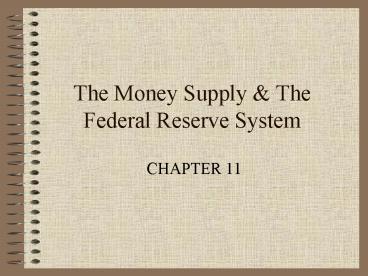The Money Supply
1 / 16
Title:
The Money Supply
Description:
Money is a means of payment or medium of exchange of which without ... The government also avoids debasement by not printing too much to avoid losing its value. ... – PowerPoint PPT presentation
Number of Views:49
Avg rating:3.0/5.0
Title: The Money Supply
1
The Money Supply The Federal Reserve System
- CHAPTER 11
2
What is money?
- Anything generally accepted as a medium of
exchange. - Money is a means of payment or medium of exchange
of which without results in trade by barter. - Money is a store of value that can be used when
desired. - i.e. transporting purchasing power from one time
period to another.
3
- Money is a unit of account, that is, a consistent
way of quoting prices.
4
Commodity Fiat Money
- Commodity monies are those items used as money
that also have an intrinsic value in some other
use e.g. cigarettes. - Fiat money, also known as token money is
intrinsically worthless but has value because of
its acceptability. - The government takes steps to ensure this
acceptability by declaring it to be legal tender. - The government also avoids debasement by not
printing too much to avoid losing its value.
5
Different Measures of the Supply of Money in the
United States
- M1 is transactions money and is made up of
currency held outside banks, demand deposits,
travelers checks, and other checkable deposits. - It is all the forms of money that can be directly
used for transactions. - M2 is bond money which includes near monies.
- these are close substitutes for transactions
money.
6
- Beyond M2 are measures that incorporate a wide
variety of financial instruments that have some
resemblance to money.
7
The Private Banking System
- Banks and other financial institutions borrow
from individuals or firms with excess funds and
lend to those who need funds. - The main types are commercial banks, savings and
loan associations, life insurance companies, and
pension funds.
8
How Banks Create Money
- History -
- In the 15th 16th Centuries people used gold for
money. The practice developed of leaving it with
goldsmiths for safekeeping in exchange for a
receipts. In time the receipts themselves came to
be traded for goods. This was an early form of
paper money. This works well as long as people
are confident otherwise there could be a run.
9
Modern banking System
- A banks assets are its loans, vaults cash, and
deposits at the Federal Reserve (reserves). - A banks liabilities are deposits owed to
customers. - Banks are legally required to hold a certain
percentage of their deposit liabilities as
reserves - - the percentage is the required reserve ratio.
10
- The Creation of Money
- occurs when when banks make loans. Banks can lend
up to the amount of their excess reserves, and
when a loan is made, a demand deposit is created
for the borrower, which the borrower can then
spend - The money multiplier is
- the multiple by which deposits can increase for
every dollar in reserve .
11
The Federal Reserve System
- Fed was created in 1913 by an Act of Congress.
- It is made up of a Board of Governors and 12
Federal Reserve Banks. - Monetary policy is set by the Federal Open market
Committee which sets goals for the money supply
and interest rates and directs the Open Market
Desk at the New York Federal Reserve Bank.
12
- Federal Reserve Banks
- The 12 Federal Reserve banks in the Federal
Reserve System represent different geographical
areas (district) of the United States. Each bank
publishes its own monthly letter or review that
includes economic data about its region. - The 12 banks by district are
- Boston (1), NY (2), Philadelphia (3), Cleveland
(4), Richmond(5), Atlanta (6), Chicago (7), St.
Louis (8), Minneapolis (9), Kansas City (10),
Dallas (11), and San Francisco (12)
13
Functions of the Fed
- While the crucial role of the Fed is to control
the money supply it also performs several
important functions for banks, including - clearing interbank payments
- regulating the banking system
- assisting banks in a difficult financial position
- manages exchange rates and the nations foreign
exchange reserves.
14
How the Fed controls the Money Supply
Controlling the Reserves
- The Required Reserve ratio
- changes in the ratio affect how much banks can
lend from their reserves. - The Discount Rate is
- the rate of interest the Fed charges on loans to
the Banks. - Open Market Operations are
- the most significant tool for for controlling
reserves. - It refers to the Fed buying and selling Treasury
securities on the open market.
15
- Two branches of the government deal in government
securities - the Treasury sells securities to finance the
deficit. - the Fed buys and sells already outstanding
Treasury securities to affect the amount of
reserves.
16
The Mechanics of Open Market Operations
- When the Fed sells securities it collects payment
and the level of reserve decreases. - The reverse happens with a purchase. Each
business day the Open Market Desk in New York Fed
buys or sells millions of dollars worth of
securities. - this is the preferred tool for controlling
reserves because it can be used with some
precision, it is extremely flexible, and the
effect on the money supply is fairly predictable.































